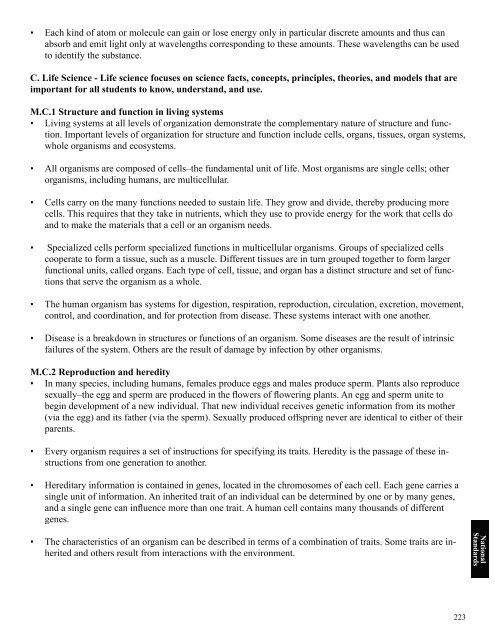ScienceMakers Toolkit Manual - The History Makers
ScienceMakers Toolkit Manual - The History Makers
ScienceMakers Toolkit Manual - The History Makers
You also want an ePaper? Increase the reach of your titles
YUMPU automatically turns print PDFs into web optimized ePapers that Google loves.
• Each kind of atom or molecule can gain or lose energy only in particular discrete amounts and thus can<br />
absorb and emit light only at wavelengths corresponding to these amounts. <strong>The</strong>se wavelengths can be used<br />
to identify the substance.<br />
C. Life Science - Life science focuses on science facts, concepts, principles, theories, and models that are<br />
important for all students to know, understand, and use.<br />
M.C.1 Structure and function in living systems<br />
• Living systems at all levels of organization demonstrate the complementary nature of structure and function.<br />
Important levels of organization for structure and function include cells, organs, tissues, organ systems,<br />
whole organisms and ecosystems.<br />
• All organisms are composed of cells–the fundamental unit of life. Most organisms are single cells; other<br />
organisms, including humans, are multicellular.<br />
• Cells carry on the many functions needed to sustain life. <strong>The</strong>y grow and divide, thereby producing more<br />
cells. This requires that they take in nutrients, which they use to provide energy for the work that cells do<br />
and to make the materials that a cell or an organism needs.<br />
• Specialized cells perform specialized functions in multicellular organisms. Groups of specialized cells<br />
cooperate to form a tissue, such as a muscle. Different tissues are in turn grouped together to form larger<br />
functional units, called organs. Each type of cell, tissue, and organ has a distinct structure and set of functions<br />
that serve the organism as a whole.<br />
• <strong>The</strong> human organism has systems for digestion, respiration, reproduction, circulation, excretion, movement,<br />
control, and coordination, and for protection from disease. <strong>The</strong>se systems interact with one another.<br />
• Disease is a breakdown in structures or functions of an organism. Some diseases are the result of intrinsic<br />
failures of the system. Others are the result of damage by infection by other organisms.<br />
M.C.2 Reproduction and heredity<br />
• In many species, including humans, females produce eggs and males produce sperm. Plants also reproduce<br />
sexually–the egg and sperm are produced in the fl owers of fl owering plants. An egg and sperm unite to<br />
begin development of a new individual. That new individual receives genetic information from its mother<br />
(via the egg) and its father (via the sperm). Sexually produced offspring never are identical to either of their<br />
parents.<br />
• Every organism requires a set of instructions for specifying its traits. Heredity is the passage of these instructions<br />
from one generation to another.<br />
• Hereditary information is contained in genes, located in the chromosomes of each cell. Each gene carries a<br />
single unit of information. An inherited trait of an individual can be determined by one or by many genes,<br />
and a single gene can infl uence more than one trait. A human cell contains many thousands of different<br />
genes.<br />
• <strong>The</strong> characteristics of an organism can be described in terms of a combination of traits. Some traits are inherited<br />
and others result from interactions with the environment.<br />
223<br />
National<br />
Standards










